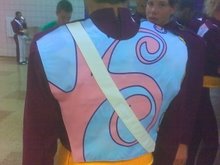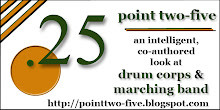Building a visual program from the ground up...(or how to stop worrying and love straight legs)
Come this fall, in addition to my work with TJ, I will become the "vis guy" for a small marching band in the area. I will be basically creating the visual program from the ground up for this band, including writing the drill. This got me thinking recently about how I should approach introducing a new visual program where one did not exist before. So this is kind of what I came up with...
Visually, there are two, and only two, things that separate the great visual groups from the bad - Timing and Posture.
I am a big believer in the philosophy of looking good before your sound good. People believe their eyes before they believe their ears. If you think differently, just think about why major orchestras make players audition behind screens. No matter what people may consciously think, everyone falls victim to visual bias sometime. The more a group can do to look better, the better the music will sound - or the better we think it sounds.
Overall, posture is important not only because it physically makes a group look better, but also because it assists in the mechanics of wind playing. Without proper torso carriage created by great posture, it is impossible to create the proper air support to produce a good sound.
Posture is clearly more difficult to obtain for the larger marching instruments. Contrary to what you may think though, Marching Baritones and Euphoniums (bell-front, not the over-the-shoulder or the "cradle" kinds)
have a much more difficult time with posture than a contra-style tuba. The difference has to do with weight distribution. Marching Baritones force the player to hold the entirety of the weight in their arms projected out in front of them. In order to counteract this unnatural stress on the torso, the player has a tendency to lean and arch their back in an attempt to center some of the weight over their hips. The correct way to maintain posture is to have the player think about using their arm muscles to support the horn. While this is not exactly the best way to actually hold the horn, it is the best way to think about holding the horn because it makes the player focus on keeping the weight in front of them and they will automatically straighten their back.
Timing is the second pillar of visual cleanliness. The golden rule I live by is that sloppy technique equals bad timing. The simplest technique to define timing wise is the straight-legged technique. The heel hits the ground on the downbeat and the legs follows through and crosses the other leg on the "and" count. Also on the "and" count, the toe of the stationary "plan" leg should be making contact with the ground. The bast way to improve the timing of a group is to first of all define where things should be at different points. Secondly, working with a metronome, subdividing the beat and slowing down simple exercises gives the performer an opportunity to analyze and correct themselves. Group vocalizations - maybe "and" or "cross" - can help train and standardize the group. Lastly, performers should be able to subdivide to music without the assistance of a metronome. Giving simple subdividing movements to recorded music can help with this.
So this is a start for me, I will be posting more as I figure more things out.![]() drum corps ;
drum corps ; ![]() DCI ;
DCI ; ![]() marching band
marching band
Continue reading...




